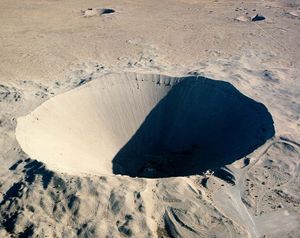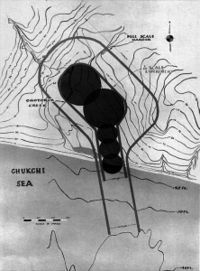Project Plowshare
and should NOT be used for any reason other than reading enjoyment |
Operation Plowshare, better known to civilians as Project Plowshare, not to be confused with the anti-nuclear Plowshares Movement, was the overall United States term for the development of techniques to use nuclear explosives for peaceful construction purposes. The phrase was coined in 1961, taken from Micah 4:3 ("And he shall judge among the nations, and shall rebuke many people: and they shall beat their swords into plowshares, and their spears into pruning hooks: nation shall not lift up sword against nation, neither shall they learn war any more"). It was the U.S. portion of what are called Peaceful Nuclear Explosions (PNE). The Soviet Union had a similar program of testing as well for many years. The Soviet program was titled Nuclear Explosions for the National Economy.
Suggested usage
Proposed uses included widening the Panama Canal, constructing a new sea-level waterway through Nicaragua nicknamed the "Pan-Atomic Canal", cutting paths through mountainous areas for highways, and connecting inland river systems. Other proposals involved blasting underground caverns for water, natural gas, and petroleum storage. Serious consideration was also given to using these explosives for various mining operations. One proposal suggested using nuclear blasts to connect underground aquifers in Arizona. Another plan involved surface blasting on the western slope of California's Sacramento Valley for a water transport project. At the end of the program, a major objective was to develop nuclear explosives, and blast techniques, for stimulating the flow of natural gas in "tight" underground reservoir formations.
Nuclear explosives have not been used for commercial engineering purposes in the United States, but the concept has been tested.
One of the Chariot schemes involved chaining five thermonuclear devices to create the artificial harbor. One of the first plowshare nuclear blast cratering proposals that came close to being carried out was Project Chariot, which would have used several hydrogen bombs to create an artificial harbor at Cape Thompson, Alaska. It was never carried out due to concerns for the native populations and the fact that there was little potential use for the harbor to justify its risk and expense. After the project was terminated, a proof-of-concept 104 kiloton (435 terajoules) cratering blast was conducted on July 6, 1962, at the north end of Yucca Flats, within the Atomic Energy Commission's Nevada Test Site (NTS) in southern Nevada. The shot, "Sedan", displaced more than 12 million short tons (11 teragrams) of soil and resulted in a radioactive cloud that rose to an altitude of 12,000 ft (3.7 km). The radioactive dust plume headed northeast and then east towards the Mississippi River.
The first PNE blast was Project GNOME, conducted on December 10, 1961, in a salt bed 24 mi (39 km) southeast of Carlsbad, New Mexico. The explosion released 3.1 kilotons (13 TJ) of energy yield at a depth of 361 meters (1,184 ft) which resulted in the formation of a 170 ft diameter, 80 ft high (52 by 25 m) cavity. The test had many objectives. The most public of these involved the generation of steam which could then be used to generate electricity. Another objective was the production of useful radioisotopes and their recovery. Another experiment involved neutron time-of-flight physics. A fourth experiment involved geophysical studies based upon the timed seismic source. Only the last objective was considered a complete success. The blast, unintentionally, vented radioactive steam while the press watched. The partly developed Project Coach detonation experiment, which was to follow adjacent to the Gnome test, was then canceled.
Over the next 11 years, 26 more nuclear explosion tests were conducted under the U.S. PNE program. Funding quietly ended in 1977. Costs for the program have been estimated at more than (US) $770 million.
Natural gas stimulation experiment
The final PNE blast took place on 17 May 1973, under Fawn Creek, 76.4 km north of Grand Junction, Colorado. Three 30 kiloton detonations took place simultaneously at depths of 1,758, 1,875, and 2,015 meters. It was the third nuclear explosion experiment intended to stimulate the flow of natural gas from "tight" formation gas fields. Industrial participants included the El Paso Natural Gas Company for the Gasbuggy test; Austral Oil Company; CER Geonuclear Corporation for the Rulison test; and CER Geonuclear Corporation for the Rio Blanco test.
If it were successful, plans called for the use of hundreds of specialized nuclear explosives in the western Rockies gas fields. The previous two tests had indicated that the produced natural gas would be too radioactive for safe use. After the test, it was found that the blast cavities had not connected as hoped, and the resulting gas still contained unacceptable levels of radionuclides.
By 1974, approximately $82 million dollars had been invested in the nuclear gas stimulation technology program. It was estimated that even after 25 years of gas production of all the natural gas deemed recoverable, that only 15 to 40 percent of the investment could be recovered.
Also, the concept that stove burners in California might soon emit trace amounts of blast radionuclides into family homes did not sit well with the general public. The contaminated well gas was never channeled into commercial supply lines.
The U.S. conducted twenty-seven PNE shots in conjunction with other, weapons-related, test series.
A Personal Note from Robin
Bob Mullen and I formed and owned a company called "BlastMasters". We did an experiment with a binary explosive (ANFO) to test the feasibility of recovering oil from oil shale. We "blew up" a square mile of Utah as part of this test.
See also Early BackDrop and/or Vela Uniform
What links here • References and Sources • Help • Contact info • Category:Root ⤴

